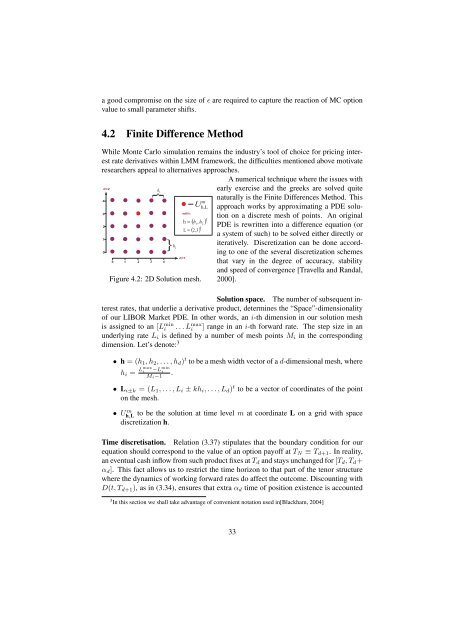sparse grid method in the libor market model. option valuation and the
sparse grid method in the libor market model. option valuation and the
sparse grid method in the libor market model. option valuation and the
Create successful ePaper yourself
Turn your PDF publications into a flip-book with our unique Google optimized e-Paper software.
a good compromise on <strong>the</strong> size of ɛ are required to capture <strong>the</strong> reaction of MC <strong>option</strong><br />
value to small parameter shifts.<br />
4.2 F<strong>in</strong>ite Difference Method<br />
While Monte Carlo simulation rema<strong>in</strong>s <strong>the</strong> <strong>in</strong>dustry’s tool of choice for pric<strong>in</strong>g <strong>in</strong>terest<br />
rate derivatives with<strong>in</strong> LMM framework, <strong>the</strong> difficulties mentioned above motivate<br />
researchers appeal to alternatives approaches.<br />
d=2<br />
4<br />
3<br />
2<br />
1<br />
0<br />
0<br />
1<br />
2<br />
h<br />
1<br />
}<br />
3<br />
4<br />
} h 2<br />
with:<br />
d=1<br />
h=<br />
L=<br />
m<br />
U h , L<br />
( h 1,h<br />
) t<br />
2<br />
( 2,3) t<br />
Figure 4.2: 2D Solution mesh.<br />
A numerical technique where <strong>the</strong> issues with<br />
early exercise <strong>and</strong> <strong>the</strong> greeks are solved quite<br />
naturally is <strong>the</strong> F<strong>in</strong>ite Differences Method. This<br />
approach works by approximat<strong>in</strong>g a PDE solution<br />
on a discrete mesh of po<strong>in</strong>ts. An orig<strong>in</strong>al<br />
PDE is rewritten <strong>in</strong>to a difference equation (or<br />
a system of such) to be solved ei<strong>the</strong>r directly or<br />
iteratively. Discretization can be done accord<strong>in</strong>g<br />
to one of <strong>the</strong> several discretization schemes<br />
that vary <strong>in</strong> <strong>the</strong> degree of accuracy, stability<br />
<strong>and</strong> speed of convergence [Travella <strong>and</strong> R<strong>and</strong>al,<br />
2000].<br />
Solution space. The number of subsequent <strong>in</strong>terest<br />
rates, that underlie a derivative product, determ<strong>in</strong>es <strong>the</strong> “Space”-dimensionality<br />
of our LIBOR Market PDE. In o<strong>the</strong>r words, an i-th dimension <strong>in</strong> our solution mesh<br />
is assigned to an [L m<strong>in</strong><br />
i . . . L max<br />
i ] range <strong>in</strong> an i-th forward rate. The step size <strong>in</strong> an<br />
underly<strong>in</strong>g rate L i is def<strong>in</strong>ed by a number of mesh po<strong>in</strong>ts M i <strong>in</strong> <strong>the</strong> correspond<strong>in</strong>g<br />
dimension. Let’s denote: 3<br />
• h = (h 1 , h 2 , . . . , h d ) t to be a mesh width vector of a d-dimensional mesh, where<br />
h i = Lmax i<br />
−L m<strong>in</strong><br />
i<br />
M i −1<br />
.<br />
• L i±k = (L 1 , . . . , L i ± kh i , . . . , L d ) t to be a vector of coord<strong>in</strong>ates of <strong>the</strong> po<strong>in</strong>t<br />
on <strong>the</strong> mesh.<br />
• Uh,L m to be <strong>the</strong> solution at time level m at coord<strong>in</strong>ate L on a <strong>grid</strong> with space<br />
discretization h.<br />
Time discretisation. Relation (3.37) stipulates that <strong>the</strong> boundary condition for our<br />
equation should correspond to <strong>the</strong> value of an <strong>option</strong> payoff at T N ≡ T d+1 . In reality,<br />
an eventual cash <strong>in</strong>flow from such product fixes at T d <strong>and</strong> stays unchanged for [T d , T d +<br />
α d ]. This fact allows us to restrict <strong>the</strong> time horizon to that part of <strong>the</strong> tenor structure<br />
where <strong>the</strong> dynamics of work<strong>in</strong>g forward rates do affect <strong>the</strong> outcome. Discount<strong>in</strong>g with<br />
D(t, T d+1 ), as <strong>in</strong> (3.34), ensures that extra α d time of position existence is accounted<br />
3 In this section we shall take advantage of convenient notation used <strong>in</strong>[Blackham, 2004]<br />
33
















